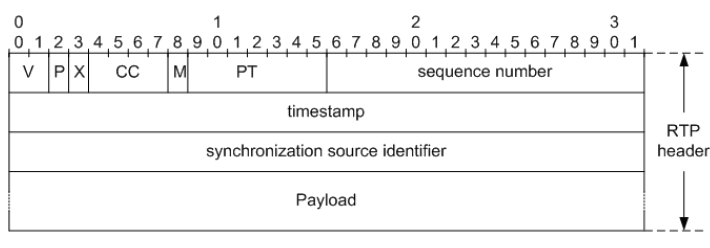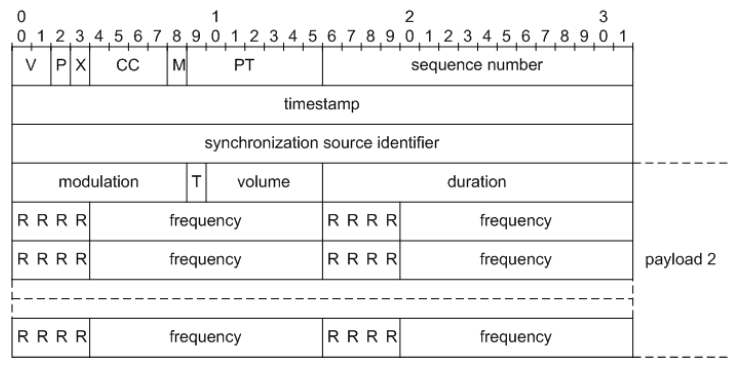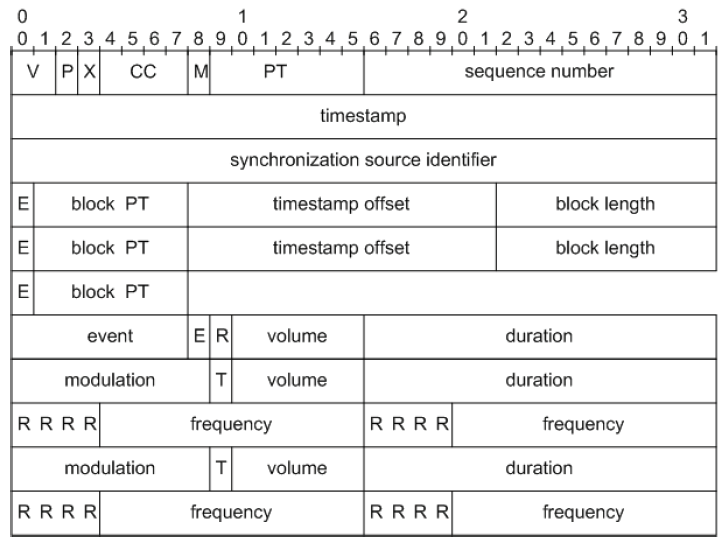ABSTRACT
We analyze the errors in the Internet packets carrying telephony signalling information. Error probability, obtained by using redundant packet sending, is also calculated. It is proved that fatal error probability, when signalling packets are sent according to standardized RTP packets, is better than it is allowed in international recommendation for analog signalling systems, but worse than it is allowed for No 7 signalling systems. The improvement is achieved by using redundant packet sending, when the error probability drops below the value intended for No 7 signalling.
BASIC CHARACTERISTICS OF RTP

Fig.1. RTP packet.
Payload field of RTP packet carries user payload. In this case, we are interested in part of payload carrying signalling information. Signalling information can be transferred in two ways: by payload carrying the information about signals as events, section 3, and payload carrying the signal parameters, section 4. The formats for transfer of signals in these two ways are shown in figures 1 and 2, respectively.
RTP PAYLOAD CARRYING SIGNALLING EVENTS

Fig.2. RTP packet of first kind.
That way, the incoming gateway receives the event code and may reconstruct the signal with prescribed characteristics regardless of the signal characteristics in incoming gateway. The RTP payload fields significant for transfer of signal as an event are event, volume, duration and end (E), Fig. 2.
RTP PAYLOAD CARRYING SIGNALLING PARAMETERS

Fig.3. RTP packet of second kind.
The incoming gateway may recognize the signal or discard the signalling packet. This RTP payload consists of 4 common octets and 2 octets for each signalling frequency, Fig. 3. As usual, R bits are reserved bits and are ignored at the receiver. This RTP packet and its payload will be called the RTP packet and RTP payload of second kind (payload 2). The advantage of this transfer method is the lack of waiting time for signal recognition that may last several seconds.
ERROR IMPACT
The errors in transfer of payload 2 may or may not be fatal. Like in payload 1, sensitivity to errors depends on field containing error. (Errors in reserved fields/bits (R) are without influence). The error in field T causes useless signalling RTP packet with payload 2. It should be noted that the frequencies determined by this parameter are used very rarely. The errors in the field volume may be detected using fields modulation and duration in the similar way as for payload 1.
REDUNDANT PACKET SENDING

Fig.6. The structure of the redundant packet.
Redundant signal sending is used in order to improve the reliability in message sending over Internet. The method can be applied by presenting one signal in two different fashions, or by sending the message, which presents the signal, two (or more) times over Internet. Also, it is possible to send the detected signal first as the primary content together with the signals, which are retransmitted, because they are detected in the previous detection intervals.
CONCLUSION
The transfer of signalling telephone signals by RTP may be recommended for lines of good quality. The probability of invalid signalling RTP packet is about 100·BER. For modern transmission media, where the value of BER is 10-9 – 10-8, the probability of invalid signalling RTP packet may be estimated as 10-7 – 10-6. The errors in the packet header are the main cause of invalid packets. From simple calculation we may see that the reliability of signal transfer is approximately same in both methods of transfer. The redundancy of packet fields in payloads diminishes the probability of useless packet.
The comparison of invalid RTP packet probability to the largest allowed error probability in transmission of R2 signals, (10-5 to 10-4), and to the largest allowed probability of undetected error in CCS No 7, (10-10), shows that the probability of invalid (useless) signalling RTP packets is between these two values. The probability of R2 signalling improvement can be achieved by redundant signal transferring. The signals are repeated twice. We analyzed the fatal error probability for two special cases. The fatal error probability in those situations for the BER of 10-9 – 10-8 is less than 1.6·10-12, which is better than the largest allowed error probability for CCS No 7.
Source: IRITEL
Authors: Aleksandar Lebl | Dragan Mitic | Žarko Markov